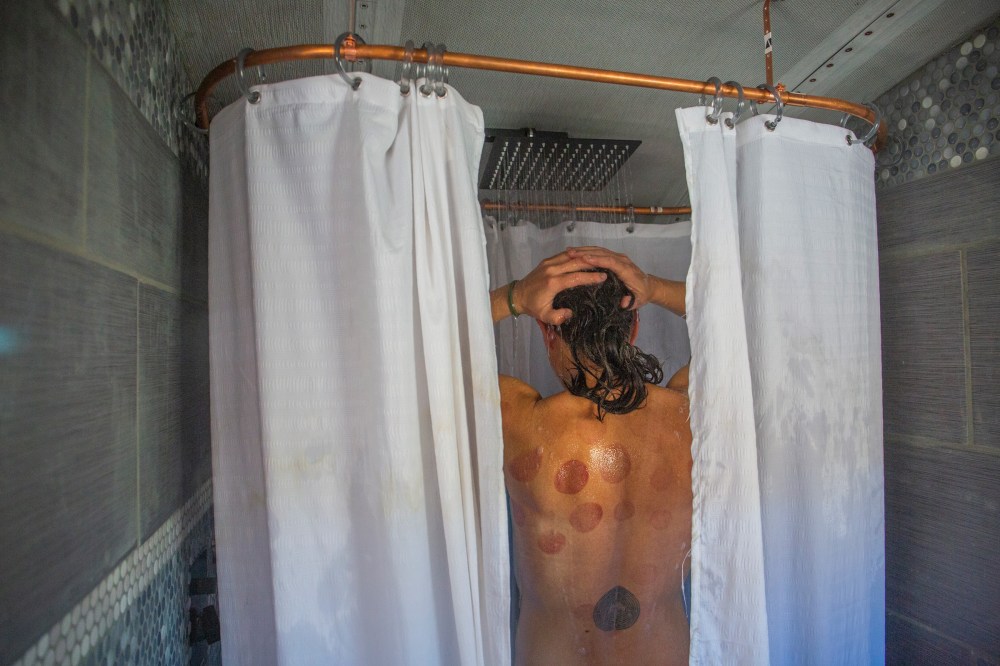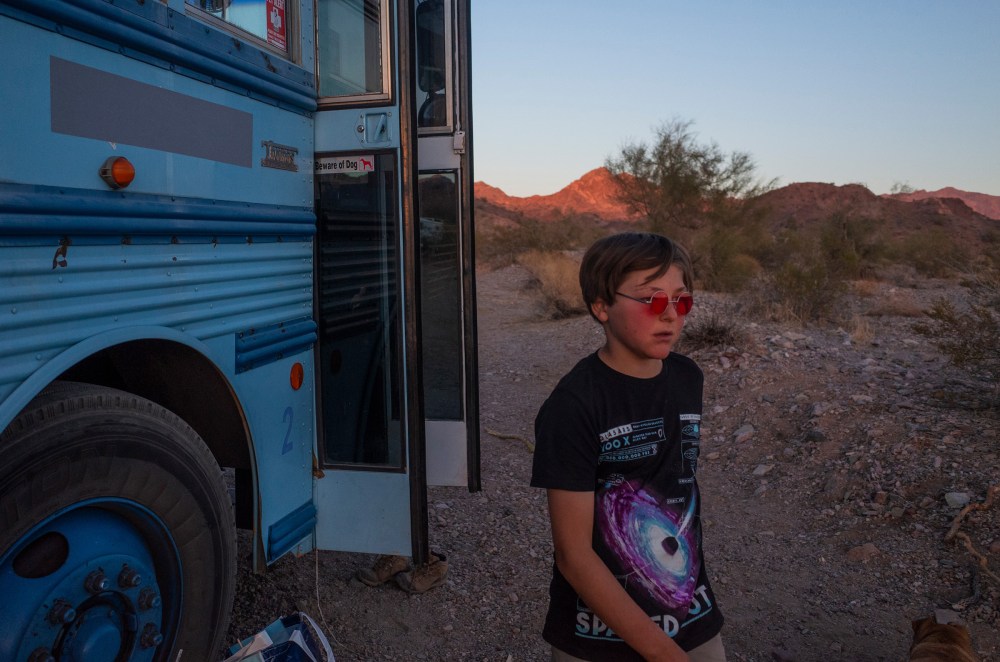This platform is gonna help you a lot to grow in your educational areas
We will provide you the best materials to prepare for any exams.
Learning gives creativity, creativity leads to thinking, thinking provides knowledge, and knowledge makes you great.
“If you want to shine like a sun. First burn like a sun.”
Friday, 30 April 2021
New top story from Time: Limbo Is a Wry and Tender Comedy About Refugees Searching for the Meaning of ‘Home’
Though some filmmakers might insist you can make a film about a hot-button issue like the refugee crisis, in the end you can only make films about people. Limbo, the second feature from Scottish director Ben Sharrock, is about people who happen to be refugees, a group of young men from various nations who have been given temporary shelter on a remote Scottish island as they wait to see if they’ve been granted asylum. Their housing, a nest of nondescript little cottages, bears a handmade sign that reads REFUGEES WELCOME with a heart appended. Some of the locals do welcome them with well-meaning but misguided enthusiasm (by offering, for instance, a clumsy “cultural awareness” course that’s designed to indoctrinate the newcomers to western ways but succeeds only in bewildering them), while others, particularly the local teenagers, inflict indifferent hostility. To the islanders, all of the men are outsiders, strangers from other lands. But they’re also outsiders to one another, a group of lost souls coming from a jumble of different cultures and backgrounds. Even so, one anxiety unifies them: no one wants to, or can afford to, be sent back.
Omar (Amir El-Masry) has come from Syria, a country his parents have also fled, though they’ve settled—and are only just getting by—in Istanbul. Omar’s older brother, Nabil, has stayed behind to fight for his country, and it becomes clear that the brothers’ forked paths have caused a rift between them. Omar is a gifted musician—like his father and grandfather before him, he plays the oud—though before he left Syria, he injured his hand and has since been unable to play. Still, everywhere he goes on the island, he carries the instrument with him, as if it were the whole of his past tucked inside a case. He doesn’t dare let go of it.

If all of that makes Limbo sound tremendously heavy, the opposite is true: this is perhaps more than anything a comedy, a picture whose dry wit recalls that of another Scottish filmmaker, Bill Forsyth, who, in the 1980s, gave us wonderfully wry comedies like Gregory’s Girl and Local Hero. Sharrock has a similar lightness of touch, even though his film has some serious underpinnings: It’s a reflection on what happens when individuals from disparate places get together and need to define, for themselves above all, what “home” means and what it means to leave it.
Read more reviews by Stephanie Zacharek
Omar, handsome but sullen, with soft, brooding eyes, has three roommates: Abedi (Kwabena Ansah) and Wasef (Ola Orebiyi) are from Ghana and Nigeria respectively, though they have presented themselves as brothers, hoping to strengthen their chances of getting asylum—a gentle metaphor for the way two people desperate to find a better life can become a kind of family. But Omar becomes closest with Farhad (Vikash Bhai), who’s from Afghanistan. (In one of their early encounters, Omar asks Farhad how, in his home country, it’s possible to tell what women are thinking if their faces are covered, a way of reinforcing the point that their two countries are hardly the same.) Farhad is resourceful, enterprising and sensitive: He scrounges things he needs—and some things he doesn’t, like a hat designed to look like a panda face—from the local donation center. He tells Omar about his hero, Freddie Mercury, whose picture he carries with him always: He and Freddie have the same mustache, he points out, and the same religion, Zoroastrianism. At home, Farhad had a chicken he loved, named after Mercury; in his desolate, temporary Scottish home, he adopts another, also named Freddie, who, to the consternation of the others, becomes a fifth roommate.
Farhad also becomes Omar’s agent-slash-manager, urging him to pick up the oud again. Omar’s hand has healed, but he refuses to play, or simply can’t. He’s frozen by uncertainty: Is he in the right place? Will he be able to help his parents, who, we learn from his fraught phone calls home, desperately need it? Should he return to his country to fight for it, as his brother is doing? Limbo, tender and searching, shows what can happen to people when they’re between points A and B, a nowheresville that can change the shape of a life forever. It’s also about the meaning of musicianship, of how songs and sound can define who we are and where we come from. When you think you have nothing, at least you have music. It’s a home you carry with you.
New top story from Time: A New Season of The Girlfriend Experience Gives Us Yet Another Exploration of Tech and Male Desire
The third season of The Girlfriend Experience begins with a job interview in virtual space. In a bare, glowing white room, Iris (a supple yet self-possessed Julia Goldani Telles of The Affair) explains to a glamorous older woman that she’s abandoning an elite undergraduate education in the States for a new life in London. Beyond a few unnerving details—sometimes the women speak without moving their lips—the meeting only seems remarkable, after a year when more people than ever were communicating mostly via technology, in the context of a show about high-end sex workers. What the protagonists of this Steven Soderbergh movie turned Starz anthology, whose alternately enthralling, stimulating and sluggish first new episodes since 2017 premiere on May 2, have in common is that each exchanges intimate physical contact for money.
Just before she clinches the gig with an exclusive escort service, Iris explains what she has to offer along with her milky skin and wide sapphire eyes: “I’m good at reading people.” This is like Joan Didion claiming to be merely “good” at reading the mood of the culture. In her new day job at an artificial intelligence company, Iris is using her precocious aptitude for neuroscience and behavioral psychology to research sexual attraction. By night, she gathers information from the field, making covert audio recordings of sessions with world leaders and pro athletes whose most deep-seated desires she is eerily skilled at detecting. At some point in every encounter, an epiphany flickers across her face and Iris—the name of a flower but also a crucial part of eyes both animal and mechanical—suddenly knows how to alter her behavior to suit her date.
The convergence of tech and desire seems like an inevitable direction for The Girlfriend Experience, whose past incarnations have juxtaposed upscale sex work with the similarly lucrative labor performed in high-level political and legal professions. Filmmaker Anja Marquardt, who joined the series after two seasons written and directed by creators Amy Seimetz and Lodge Kerrigan, clearly has a fascination with this sort of labor; her 2014 feature She’s Lost Control follows a female psychology grad student who works as sexual surrogate. And in many ways, the character-driven story Marquardt tells is a return to form for a show that excelled most in a debut season focused on a law-student escort played by Riley Keough.

Like that character, Iris is brilliant, beautiful and appears to have her life under meticulously compartmentalized control… until her situation devolves enough to reveal how fragile it was all along. Marquardt spends much of the first half-season setting a mood of eerie, clinical calm. (I was provided with five episodes, out of 10 total.) In apartments and offices whose aesthetics seem to be converging along with their functions, the atmosphere is both luxe and minimalistic: brushed metal surfaces, mammoth glass windows, monastic concrete walls, furniture and clothing in all the bloodless colors of the iPad rainbow. Iris explains mirror neurons—“our ability to perceive what someone’s thinking or feeling”—to a coworker and mirrors become a visual motif. When Iris mirrors the desires of her clients, she becomes a sentient version of the A.I. she’s studying by day. Mechanical eyes as well as human ones use an iris to let in light.
It’s refreshing to see TV take on big ideas from science and philosophy without dumbing them down out of deference to network executives’ knee-jerk underestimation of their audience. And this immersion in an existence that blurs the line between humanity and technology can be intriguing. But the show moves so slowly as it deepens these thematic connections (thematic neural networks?), drawing artificial limbs and deepfakes and fatalism into its web of metaphors, that the plot barely starts moving until episode 5. It’s hard to say, midway through the season, whether the next five episodes will justify the patience it takes to get to that far.
In the meantime, perhaps the scene-setting feels as redundant as it does because anxiety around the intersection of love, sex and technology has—for obvious reasons—become a pop-culture obsession. Specifically, we keep getting dark visions of heterosexual male desire filtered through computers and robotics. This month’s HBO Max adaptation of Alissa Nutting’s novel Made for Love introduced an all-powerful tech mogul who wouldn’t rest until he’d invaded every corner of his wife’s consciousness. Before that, Humans saw a family thrown into crisis following the father’s indiscretion with their robot assistant. In Ex Machina, Oscar Isaac memorably played a reclusive search-engine CEO whose only companions are model-gorgeous android babes. It all harkens back to that pessimistic, Stepford Wives notion that what men want most from women is not connection but submission (even if what the woman is submitting to turns out to be a male fantasy of female domination). The girlfriend experience without the girlfriend obligation.
It makes sense for art to interrogate patriarchal desire. So much of the world we live in has been, and continues to be, shaped by it; that goes double for the male-dominated tech realm. Still: as we look to a future mediated by A.I., why do we still spend so little time imagining how technological advances might intersect with the physical and emotional needs of people who are not straight men? This season of The Girlfriend Experience contains some promising ideas, even though it retreads some familiar ground and the gendered implications of Iris’ double life go largely unacknowledged. Next time, how about The Boyfriend Experience?
New top story from Time: America’s Single, Fully-Vaccinated Seniors Are Looking for Love Again
A few Saturdays ago, a charming teacher asked Katherine Palmer, 64, on a date at a local tavern. After a year of staying six feet apart from others, meeting up outside and wearing face masks, spending time with someone in person made her nervous at first. However, as she she started to relax into the date, she began to realize something else: they were hitting it off. Now that she’s fully vaccinated, she says, she’s ready to put her worries aside and put herself out there.
Palmer says the pandemic made her recognize that, when it comes to finding love again, there’s no time to waste. “When your husband dies, you realize life is short,” she says. “That part was definitely missing: to have somebody by your side during a pandemic that you could talk to and, you know, tell them, ‘I’m afraid about what happened today,’ and they would console you. I missed all that with my husband not being here…So maybe I want another one.”
Pandemic-era dating has been hard for pretty much everyone, but it’s been a particular challenge for older people, who are at higher risk of severe COVID-19. Many older people have changed their lifestyles accordingly over the past year—people over 60 were the most likely to practice measures that limit the spread of the virus, including physical distancing, avoiding crowds and canceling social activities, according to an Oct. 2020 survey from the U.S. Centers for Disease Control and Prevention.
When vaccines became available in the U.S. starting late last year, older residents were among the first allowed to join the line, and, broadly speaking, they jumped at the opportunity. They’re now more likely than younger people to have at least partial protection; as of April 26, more than 80% of U.S. residents over 65 were at least partially vaccinated, compared to just 32.5% of people between 18 to 29. And vaccination has enabled many older people who have spent the year in relative isolation for fear of contracting the virus to throw themselves back into a fulfilling social life—including dating.
Palmer, who received her second vaccine in early April, says her social calendar is already full again. However, she may not be playing the field for as long as she expected: the teacher impressed her with his bluntness, fun-loving spirit, and respect her and caution towards COVID-19. As their first date was going well, he turned to her and said, “Full disclosure: I had COVID in July.”
“Oh, really?” she responded.
“And I was vaccinated. And you are vaccinated,” he continued. “So, can I kiss you tonight?”
“Okay, I see where this is going now. Yes, you can,” she said. (They did). Even then, she admits, it all felt strange. During the pandemic, she says, “you don’t kiss people, you don’t touch people. You know, it’s just so weird to have the shot and now have that freedom.”
For some older singles, like Marianne Mohr, who’s in her 60s, the pandemic has become a useful way to gauge whether a prospective date is a good match. If someone she connects with online suggests they haven’t taken COVID-19 seriously, Mohr doesn’t bother meeting up with them regardless of their vaccination status, because it’s a sign that they don’t share her values. The pandemic “made me be more discerning,” says Mohr.
Todd Omohundro, 60, says that as a very outgoing person, things in life used to “fall into [his] lap.” During the pandemic, however—and after a difficult shoulder surgery in November—he found himself getting increasingly lonely and depressed. As he recovered, he decided to take dating more seriously, even hiring a matchmaker. He says that he’s found even more confidence now that he’s vaccinated.
“Honestly, it was part loneliness, part desperation,” says Omohundro. “We’ve all heard those amazing stories of people passing on all over the world, isolated from any loved ones at all. And wow, you know, that iconic image we have of being at the very end of our life and being surrounded by loved ones, and you know, the family dog. I don’t want to die from COVID by myself.”
Ann Maas, 63, says that since mass vaccination began, she’s seen a growing interest in dating through her business taking people’s photos for their online dating profiles. It’s nice, she says, to see people get themselves cleaned up to get back out there. “The COVID beard and COVID extra weight does not help these men,” says Maas. “And so many women have these huge chunks of gray and colored hair. And so so many people need to get fixed up and be able to go back to their hairdressers before they go dating again. You know, so it’s not just the dating, it’s the prep for dating.”

- Evan Angelastro for TIMEJim Byrne poses for a portrait with his scooter outside of his home in Connecticut.
Many older single people, including 82-year-old Jim Byrne of Connecticut, are optimistic that it will be easier to meet people now that people are getting vaccinated and the gloom of the pandemic is starting to lift. Byrne says he’s happy to see that people are going out more, and as an actor, he’s looking forward to meeting new people once the local community theater scene gets going again. He says he’d love to meet a woman who likes to have fun—and maybe take a ride with him around Connecticut on his scooter.
“At my age, et cetera, I’m not looking for anything serious-serious, you know, like proposing to a woman and getting married. I’m not interested in that at all. Most people my age are not looking for a long-term mate. They’re just hoping to stay alive long enough to have a little enjoyment,” says Byrne. “But you know, a good friend that you can go out and enjoy life with and have fun and, you know, be a little romantic. I’m a sentimental slob.”
New top story from Time: A Year in a School Bus: Amid COVID-19, A Family Finds Freedom Traveling the American West
Paula wakes up in her bus around 4:30 a.m. most days. She can usually still see the stars. She works for a few hours, often on freelance projects using her training as a biologist, and makes breakfast when her 12-year-old son Max gets up around 7:00. (TIME has agreed to grant Paula and Max pseudonyms out of concerns for their safety.) She feeds their dog and cat, and then she and Max, who is on the autism spectrum, begin homeschooling. They follow specialized, skills-based lesson plans to keep his work short and consistent—at least two to three hours a day, seven days a week. By 10:00, they usually “hit the ground running” on renovating their bus, she says. They try to complete one project a day, big or small.
Paula, 39, and Max have lived in their 35-foot skoolie—a term for school buses which have been renovated into small mobile homes—for nearly a year, often traveling across public Bureau of Land Management (BLM) land in Arizona, California, Nevada and Utah. BLM land makes up one-tenth of the land in the U.S.—much of which is in the American West—and huge portions are available for dispersed camping, or camping away from developed recreation facilities. People in converted vehicles can park in undeveloped areas for up to two weeks at a time for free, and can stay at most campgrounds for the same time as long as they pay a fee, which ranges from $5 to over $100 a night. The BLM also runs “Longer-Term Visitor Areas” in California and Arizona between September and April, where people can stay for months at a time with the proper permits.
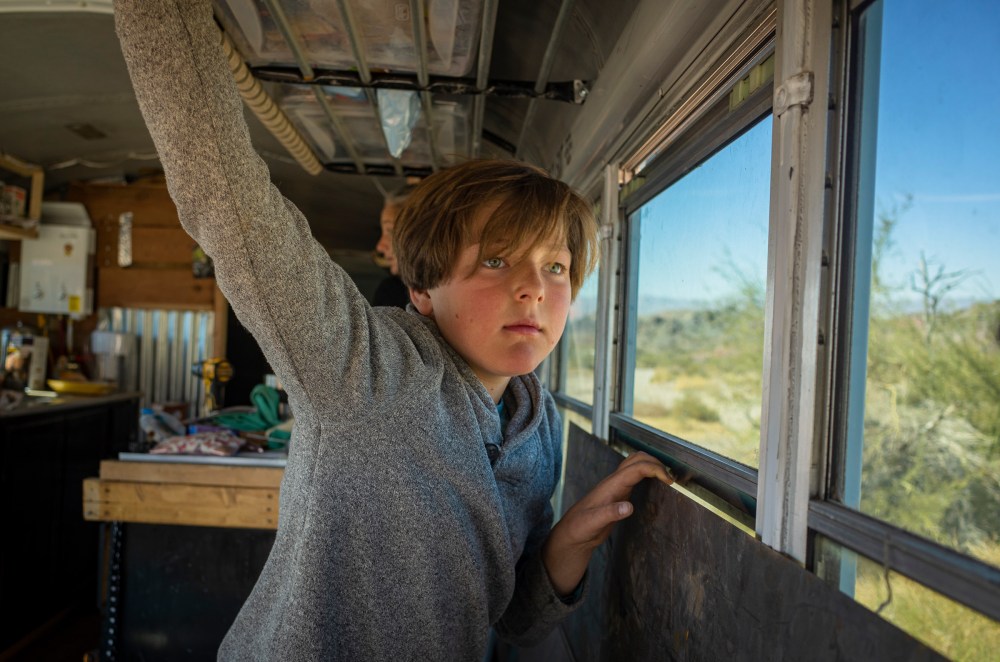
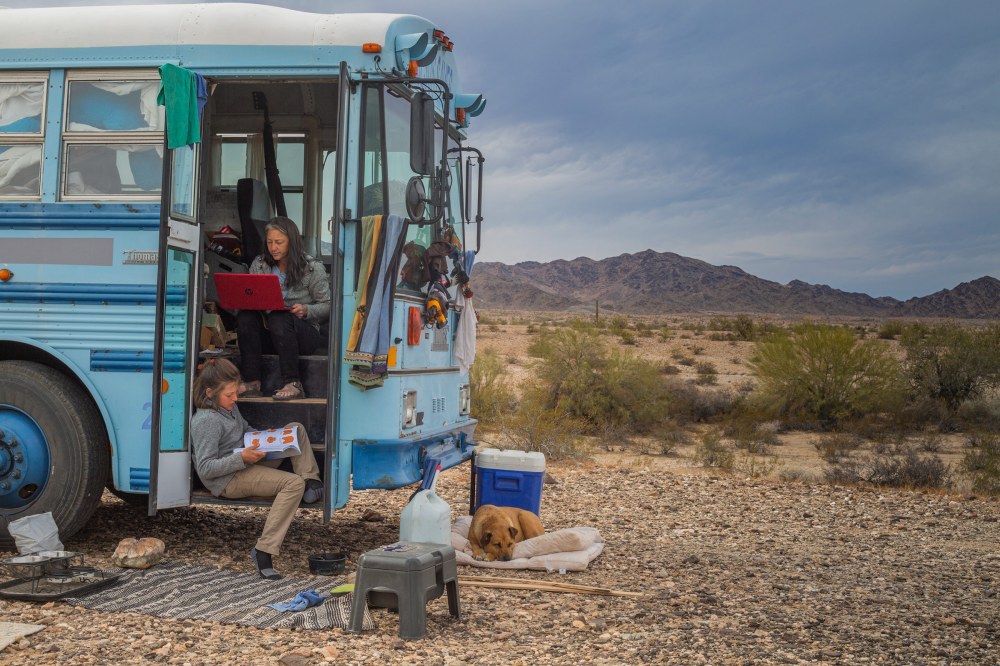

The move towards towards skoolies or converted vans—sometimes referred to as #vanlife online—has grown in recent years. It sharply ticked up during the COVID-19 pandemic, when lockdowns moved much of American life online last spring, and plunged millions into unemployment. The nomadic lifestyle can allow people to live more sustainably, affordably and with greater flexibility, and has become popular with Americans contending with rising housing costs. There’s little hard data on mobile living, but the U.S. Census Bureau estimates that in 2019 over 140,000 people were living out of vans, recreational vehicles or boats—a 38% increase from three years before. A Bureau of Land Management spokesperson tells TIME that over 19 million people visited BLM-managed land in 2020, and the use of remote locations and dispersed camping “increased significantly with more people in more places.”
Paula and Max made the move for several reasons. Skyrocketing rent compounded by recent wildfires—which have displaced Paula twice over the past five years—made finding housing where she and Max lived in Washington state near impossible, she says. She felt Max’s school system was not addressing his needs, and was tired of feeling like she had to spend hours “rattling cages” to get help. So when the pandemic hit last March and Paula lost several jobs, it was the last straw.
“I made this decision because I felt like it was proactive,” she says. “This gives me home ownership. This gives me freedom. This gives me the ability to offer my son greater opportunity in life… This is an empowering decision.”
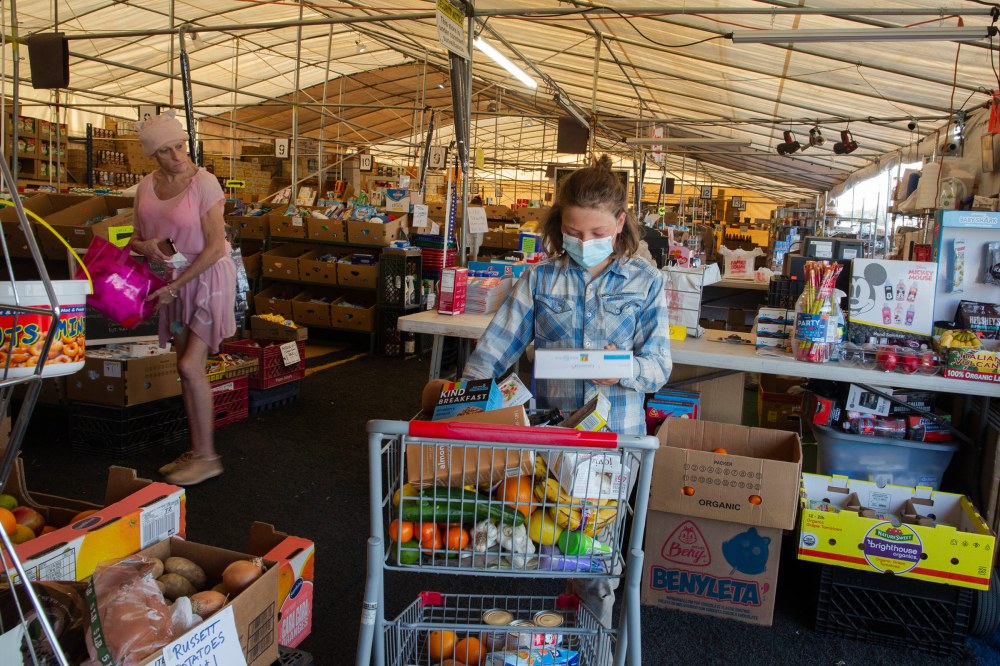
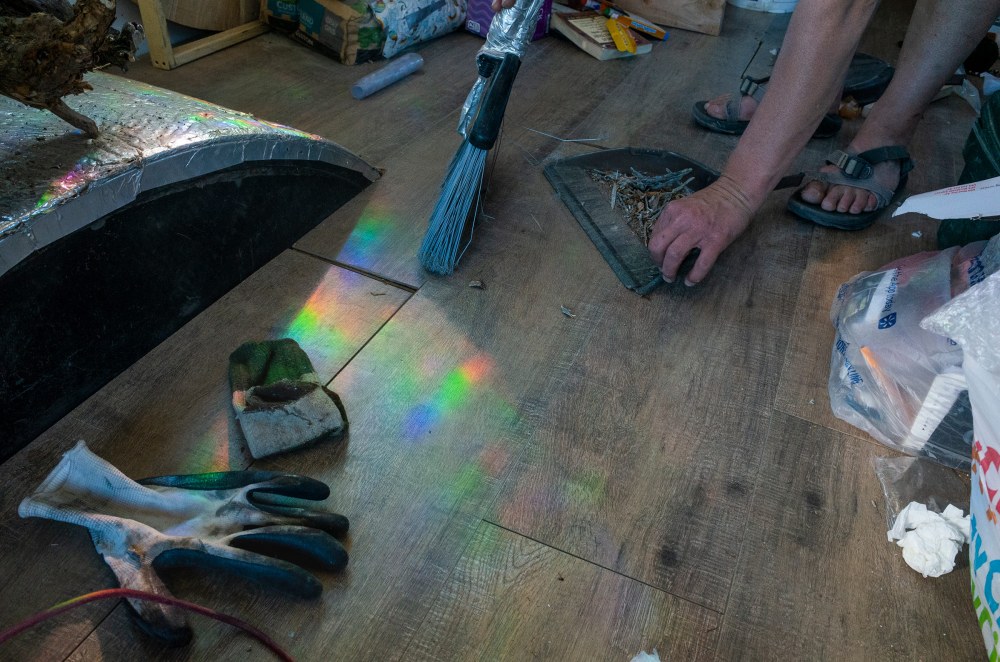

During their travels, Paula and Max have built out their new home, installed beds and closets, solar electricity and internet, a kitchen with a stove, butcher block counter tops and a fridge, a tiled bathroom complete with a toilet and a hot shower, as well as rigging for Max’s occupational therapy.
“A lot of [people] are trying to stay out of public systems,” Paula adds. “Including myself.” In addition to people who’ve been driven by the pandemic, she says she’s met people who moved into skoolies after environmental disasters destroyed their homes, or retired and want to stretch a fixed income.
But, Paula stresses, many people she’s met chose the lifestyle because they love it—like Amber Manzanares, 29, who says she’s lived out of buses or vans for over five years, because she prefers the nomadic lifestyle’s inherent focus on travel and adventure. “We’re travelers,” she says about her decision to live out of a skoolie with her family. “We enjoy the road.”
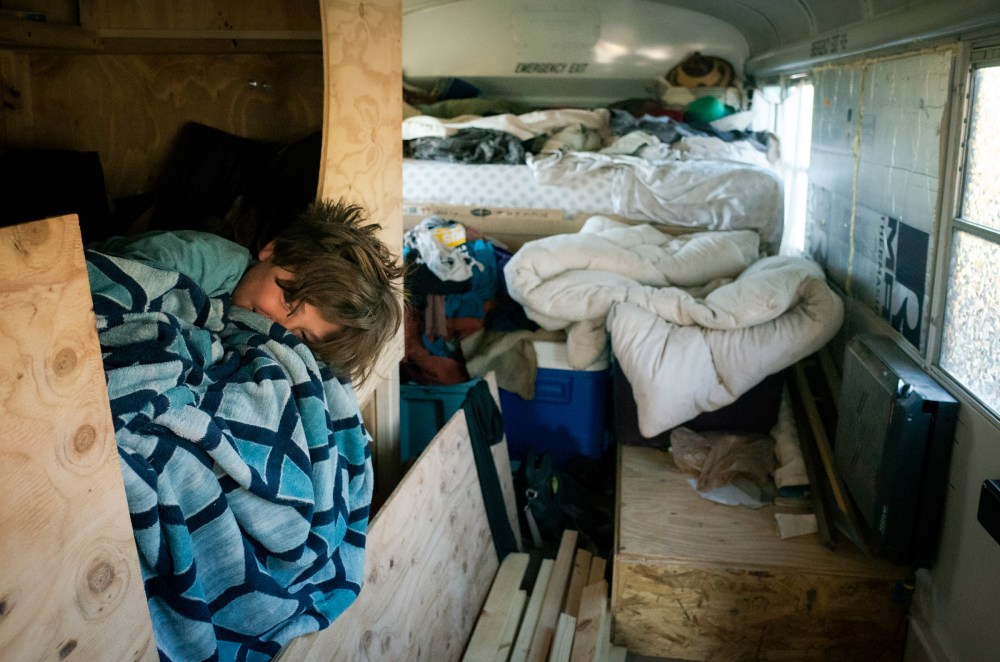
For some, the pandemic’s impact on lives and livelihoods has increased the appeal of mobile living. Arshlynne Aketch, 25, bought and renovated an orange 1972 Ford Econoline after she lost her job in Los Angeles last spring and was unable to pay rent, she says. She’s now lived out of the van, nicknamed “Creamsicle,” on BLM land for over two months. Brianna Kirk, a 19-year-old University of St. Thomas student, made the jump to her 32-foot school bus last spring and has been able to continue her studies because the pandemic moved classes online. “When you live small like this,” she says, “it opens up a world of experiences and gives you freedom to do really whatever you want.”
And Tiffany Fede, 40, and her 6-year-old son moved into their skoolie last November after her husband passed away in March of 2020. “I wanted it to be just us,” she says. “I wanted to take this time to get to know each other one-on-one.” But in their travels across public land, Fede says they’ve also found “a big, beautiful community.”
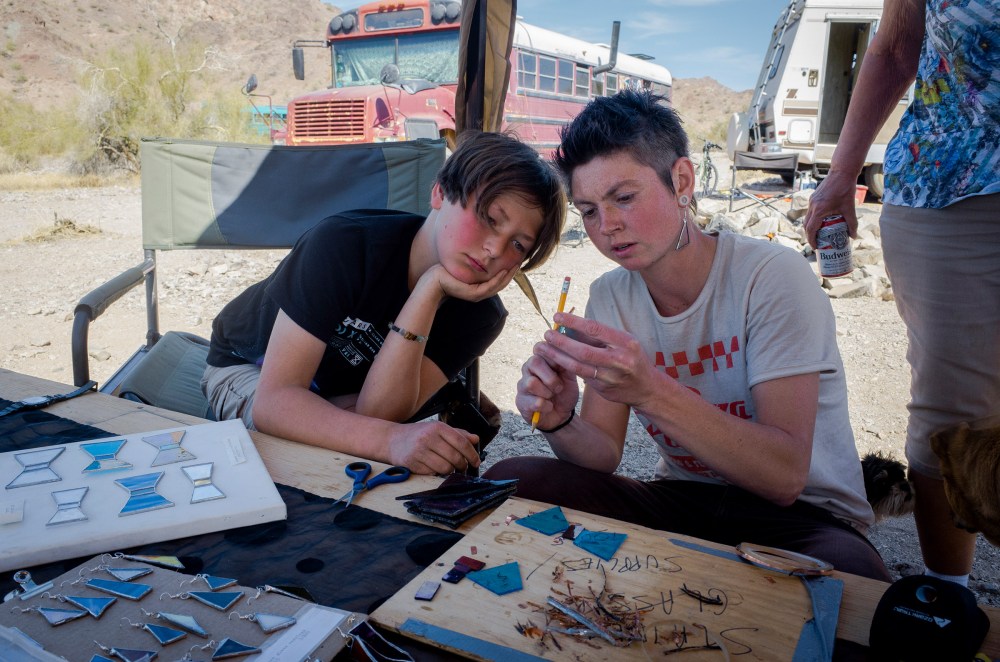
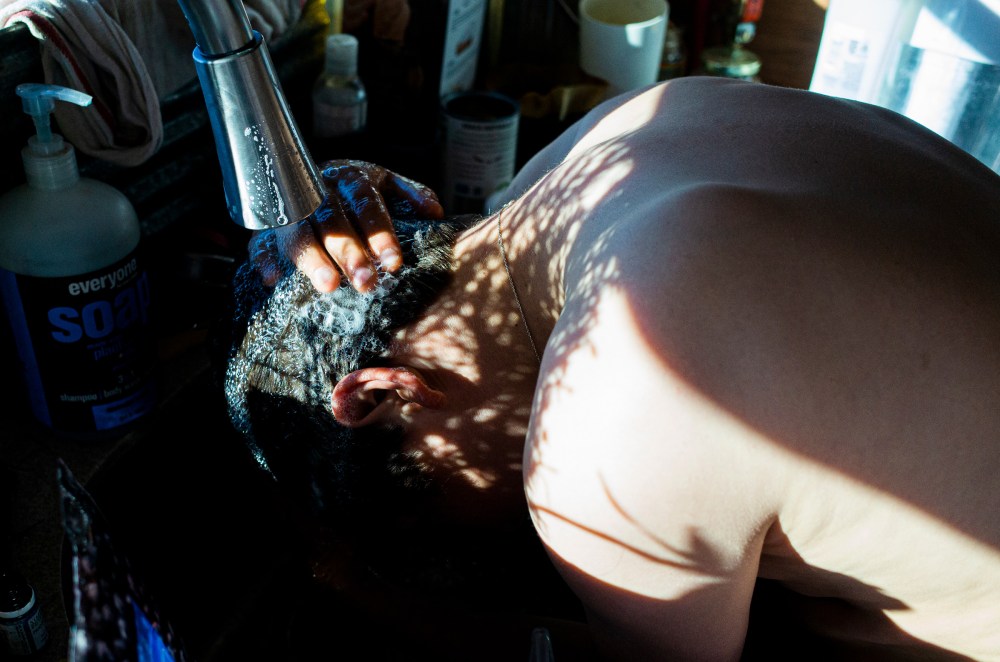
![Paula and Max embrace after working on construction projects for the bus on Feb. 20. They’re careful to clean up after themselves after renovations. Paula says that, in her experience, people living out of skoolies or vans are usually the most respectful towards the land itself. “The people who stay and do full time living, they would like to keep the privilege,†she explains. “[We're] usually the ones that go out and clean up after all of the people that leave stuff behind.â€](https://api.time.com/wp-content/uploads/2021/04/life-in-a-mobile-home-hug.jpg?w=1000&w=1000)
At the Craggy Wash BLM campground in Lake Havasu City, Arizona, where Paula and Fede traveled with people from Skooliepalooza, groups helped each other build out their rigs, cooked community meals, laid out crafting tables and organized a socially distanced pig roast. One night someone set up a projector and they all watched the Oscar-winning movie Nomadland, starring Frances McDormand as a woman living out of her van. “It is not like that for us,” Paula says, referring to the character’s struggles. While she saw parallels to her life, including the supportive community on the land, she says she doesn’t feel like she carries the same sense of grief as McDormand’s character Fern.
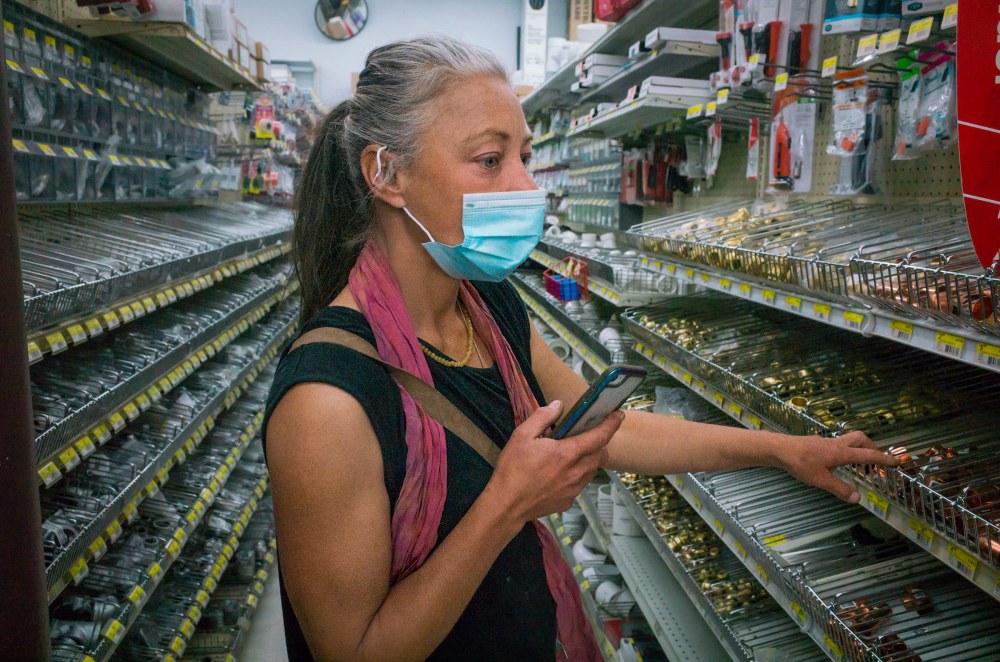
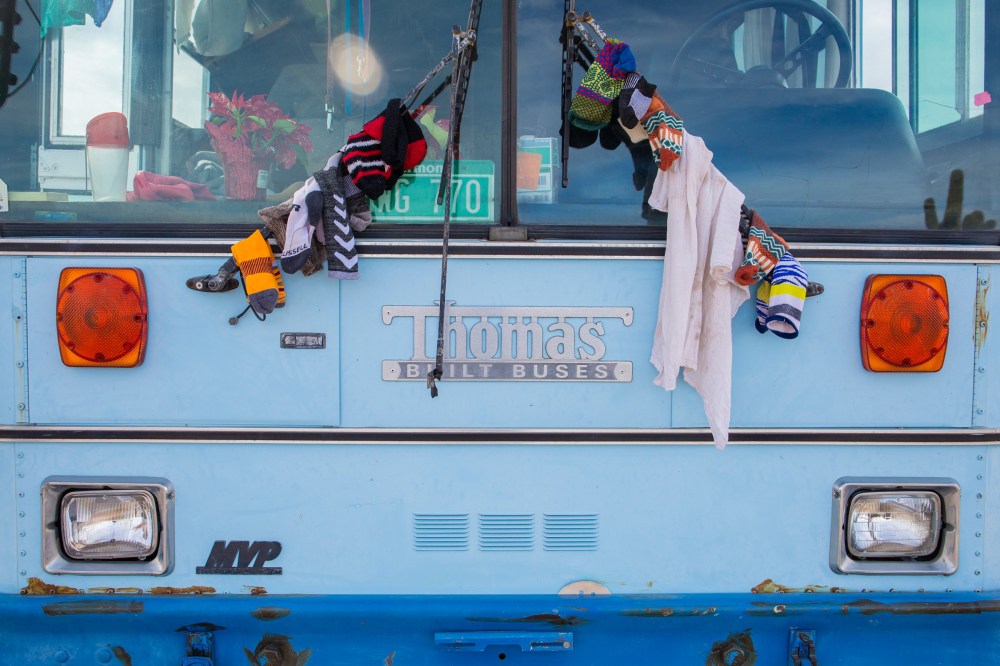
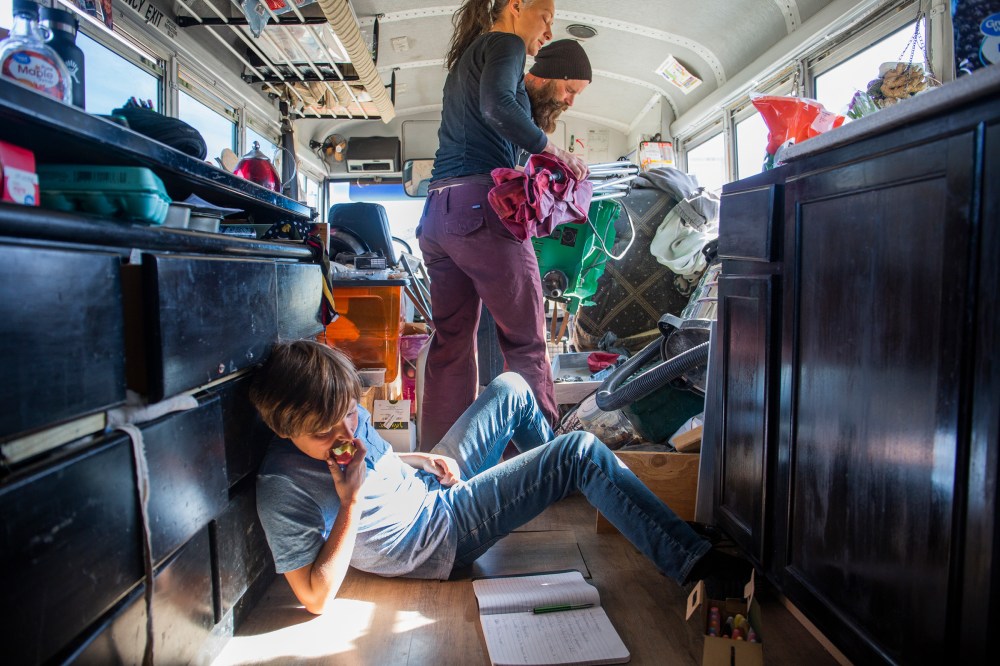
The skoolie lifestyle “would not be possible,” Kirk says, without BLM-managed public land. Many cities have criminalized living in vehicles; Aketch and Kirk both say they’ve had difficulty finding free legal parking in urban areas. But on most undeveloped public land (unless otherwise marked), they can stay for 14 days at a time completely for free. “Having these lands available to us is the only way that we can make living in a vehicle long term really work,” Kirk says. “Quite literally it is like the lifeblood of the community.”
Paula says she and Max won’t stay on BLM land forever. She’s found temporary seasonal work in the Southwest and plans on returning to Washington eventually. As she put it, “I’m going to have to park somewhere.” But for now, they’re comfortable. In the afternoons they read books, do arts and crafts or practice yoga. Paula installed a rock climbing wall on the side of the bus. Max goes on hikes. Then it’s dinner time, perhaps with friends around a campfire. Lots of laughter. Lights out for Max are at 8:30 p.m.

“I can live on the amount of money that I can bring in. I’m not worried about where we’re going to live tomorrow… I’m not running around with my head cut off looking for childcare,” Paula says. “So I’ve been pretty thrilled.”
In March, they drove through the area of California where they first began living out of the skoolie almost a year ago. Paula was overcome with emotion, she says, remembering their first night in the bus, and the fear she felt around the massive lifestyle change ahead of them.
“I just sat there and was like, ‘I can’t believe that I did this. I cannot believe how far I’ve come,'” she says. “You don’t know what you can do until you’re faced with a challenge, and then you have to do it.” She says she realized a part of her—the more fearful part—was gone, and she cried for a long time. And then she took a hot shower, made dinner, and sat outside with her son, watching the sun dip below the horizon.
